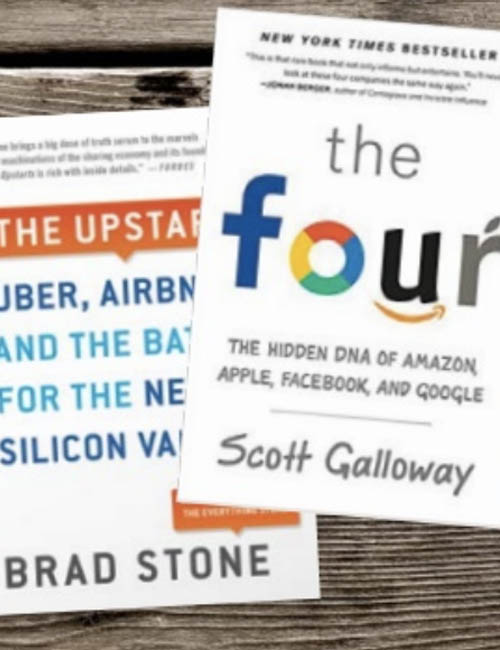Reviewed by Susan Fader, susanfader@faderfocus.com
Fader & Associates, Teaneck, NJ
Two different authors, two different writing styles, but both books have the same goal of painting a more realistic, detailed understanding of the dynamics and business goals of Amazon, Apple, Facebook, Google, Airbnb, and Uber and their impact on consumer choice and society as a whole. Both books provide a complex and in-depth perspective of these companies that goes beyond the simplified and sanitized personas that they have tried to project. They also outline and discuss the future competitive and combative roles that these companies may have with each other. While the books discuss the back-stories of the respective companies and how they are currently disrupting business models around the world, they also focus on these companies’ impact on future competition, individual consumer choice, and their shrinking of middle-class job opportunities.
Scott Galloway, the author of The Four: The Hidden DNA of Amazon, Apple, Facebook, and Google, is an NYU Stern School of Business professor and entrepreneur who weaves his classroom and tech entrepreneur experiences into his cheeky storytelling style, complete with whimsical line drawing illustrations. Stone’s goal is to warn of a possible dystopian future if Amazon, Apple, Facebook, and Google are allowed to operate unchecked. He ominously dubs these four companies the Four Horsemen, referring to the biblical Four Horsemen of the Apocalypse.
Galloway has a two-prong approach to help deliver his warning. “In the first half of this book we’ll examine each horseman and deconstruct their strategies and lessons business leaders can draw from them. In the second part of the book we’ll identify and set aside the methodology, the Four allowed to flourish around the origins of their competitive advantage.”
Galloway shares the stories of why competitive high-tech companies that were startups concurrently with the Four Horsemen—some of whom you have heard of and others that you might have not—flamed out, while the Four Horsemen were able to succeed. He also shows how the Four Horsemen utilize the military tactic of OODA, which is Observe, Orient, Decide, and Act, because “by acting quickly and decisively, you force the enemy…to respond to your last maneuver as you’re entertaining the next one.”
He outlines that while these four companies may currently appear to be in very different businesses, they are moving into each other’s territories and will soon be in direct competition with each other.
Uber is the only company that has a starring role in both books, and while Lyft is not part of the title of Brad Stone’s The Upstarts: Uber, Airbnb, and the Battle for the New Silicon Valley, it definitely has a supporting role. Stone, who is an investigative business reporter, takes a more scholarly and biographical approach to his telling of the Uber and Airbnb stories. Stone spins a fascinating tale of how Uber and Airbnb created a new type of business and that “even Uber’s most fervent supporters had not grasped the true potential of the business. Uber wasn’t just taking passengers out of yellow cabs, it was growing the overall market for paid transportation.”
The Upstarts reads like a complex detective who-done-it, which takes you from the time each business was just a kernel of an idea to how they evolved to billion-dollar companies. The Upstarts includes a fascinating parallel telling of Uber and Airbnb founders’ relationship with each other and their very different personalities and approaches to business and investors.
I found both books very informative and recommend both if you truly want to get a deeper understanding of these companies’ true impact on our lives. The Four was definitely the faster read, but The Upstarts went into the very interesting details of how multiple tech company upstarts can have the same business idea and relatively similar model, yet one company succeeds while the others may never get out of the starting gate.


Be the first to comment